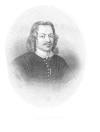|
John Bunyan

and
“THE PILGRIMS PROGRESS”
John Bunyan (28 November 1628- 31 August 1688) was
an English writer and nonconformist (Baptist)
minister. He was born at Harrowden, in the parish of Elstow, Bedfordshire, the son of a tinker. He followed that trade for
a while then served with the Parliamentary Army in the
Civil War at Newport Pagnell (1649-1655) He was converted about 1650 when he began
writing and unlicensed preaching. He was baptised into the Baptist faith in 1653 and by 1655 he had become a deacon and a successful preacher. In 1658 he was arrested for preaching without a licence. and despite warnings he continued to do so. He was then imprisoned in the county gaol at Silver Street, Bedford. in November 1660. There he was confined at first for three months, but again refused to conform and subsequently spent nearly 12 years (with the exception of a few weeks in 1666) until January 1672, when Charles II issued the Declaration of Religious Indulgence. While in prison he supported his second wife ( he remarried in 1659 following the death of his first wife) and four children by tagging laces. His book Grace Abounding was published in 1666.
In 1672 he became pastor of the Bedford church. In March 1675, he was again imprisoned in the Bedford town gaol. In six months he was free and because of his popularity was not further pursued by the authorities. The
Pilgrims Progress which was written during this period, was published in 1678.
On his way to London he caught a severe cold from being wet, and died as a result of a fever at the house of a friend at Snow Hill , London, on August 31, 1688. His grave is in the cemetery at Bunhill Fields in London.
Other prominent works include Life and Death of Mr
Badman (1680) and The Holy War
(1682). An excellent web site that has the complete works of John Bunyan available for download is at www.johnbunyan.org

The following pages tell
the tale of the Pilgrims Progress in a very
simple and graphic way. This is the form of what were
called “chap” books, which were cheaply produced
publications sold by “chapmen” – the itinerant peddlers
and door to door salesmen of the 17th and 18th century.
Please note
that in order to make the story line readable and
the detail of the picture more visible, the individual
pages are quite large jpg files. They may seem slow
loading if you are operating on an older computer or have
a slow modem. If this is a problem please let me know.
Next
|